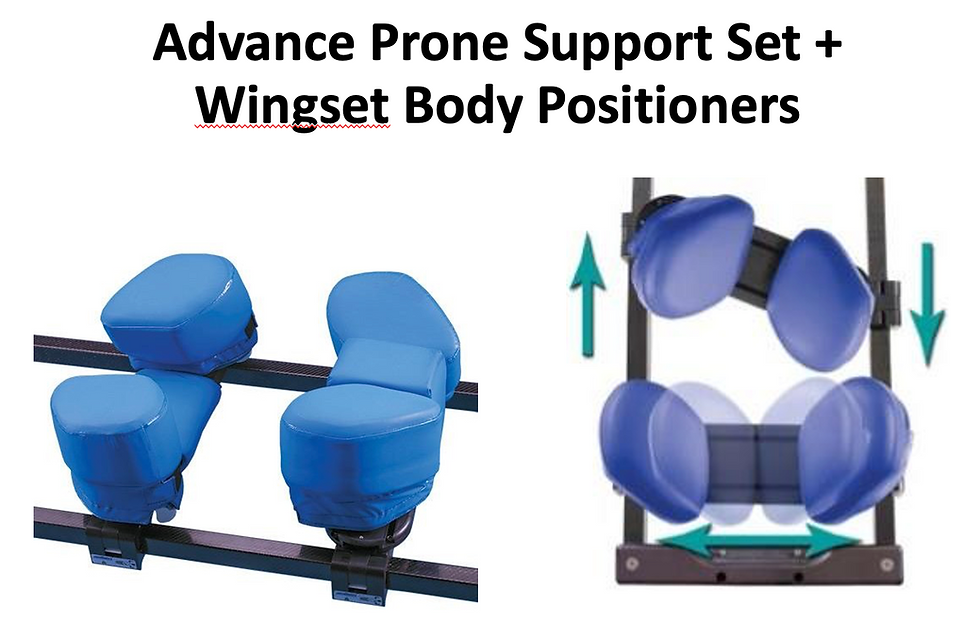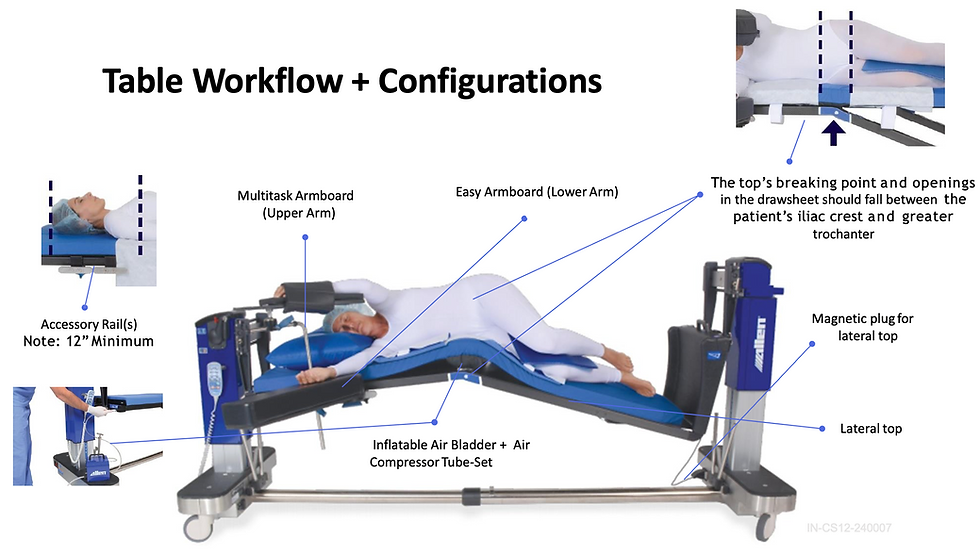Radiolucent Tables in Robotic Spine Surgery
- SpineVidya

- Dec 20, 2024
- 5 min read
Updated: Dec 30, 2024
Introduction
The integration of robotic systems in spine surgery has revolutionized the field by enabling highly precise and minimally invasive procedures. One of the key components that facilitate the success of robotic spine surgeries is the use of radiolucent operating tables. These tables allow for unobstructed imaging, essential for real-time navigation and accurate robotic interventions. This post outlines the critical role of radiolucent tables in robotic spine surgery, explores various models available, and provides detailed descriptions of their features, capabilities, and advantages.
Role of Radiolucent Tables in Robotic Spine Surgery
In robotic spine surgery, the need for continuous, high-quality imaging cannot be overstated. Radiolucent tables are designed to provide radiolucent support, allowing for unimpeded X-ray and fluoroscopic imaging. The primary function of these tables is to facilitate clear and accurate 3D imaging during procedures, ensuring that the surgeon has precise guidance for navigation and placement of instruments. The ability to obtain real-time imaging while maintaining optimal patient positioning is integral to the success of robotic spinal procedures.
Key Advantages of Radiolucent Tables:

Commonly Used Radiolucent Tables in Robotic Spine Surgery
Several radiolucent tables are frequently utilized in robotic spine surgeries. Each table offers unique features that cater to specific surgical needs, ensuring flexibility and precision in patient positioning. The most commonly used tables are:
Allen Advance Table: Known for its robust design, this table offers 360-degree rotation, comprehensive patient positioning options, and a high weight capacity, making it ideal for complex robotic spine surgeries.
Allen Table Extension: This adaptable extension transforms any standard operating table into a versatile spine surgery table, offering radiolucency and adjustable patient positioning.
Mizuho Pro-axis Table: Specifically designed for robotic spine surgery, this table features a radiolucent hinge mechanism that supports precision and stability during complex procedures.
Gentinge Maquet Magnus Table: Offering seamless integration with robotic systems, this table provides stability and radiolucency, essential for accurate navigation in robotic spinal surgery.
Allen Advance Table

The Allen Advance Table is one of the most widely used radiolucent tables in robotic spine surgery, known for its advanced features and versatile design. It is specifically engineered to support complex spine procedures, offering a combination of optimal patient positioning, imaging compatibility, and integration with robotic systems. Below, we will explore the key features, structure, and functionality of the Allen Advance Table.
Key Features and Capabilities
Weight Capacity and Rotation: The table supports up to 600 pounds, making it suitable for a wide variety of patients. Its 360-degree rotation capability ensures that the surgical team can access the patient from any angle, which is crucial during robotic spine surgery for precise positioning and navigation.
Support and Positioning:

Equipped with the Advance Prone Support Set and Wingset Body Positioners, the Allen Advance Table offers efficient patient positioning. It also supports cervical traction devices and helps reduce pressure on the brachial plexus, which is essential for long surgeries. The system allows for free abdominal hang, relieving pressure on the aorta, which is critical in spinal procedures requiring optimal positioning.
Structure and Components

Table Parts:The table consists of two pendants that support a radiolucent rail top. The rail top can accommodate various attachments, allowing for flexibility in positioning and patient care during surgery.

Pinless H-Bracket System: A key component of the table is the pinless H-bracket system, which secures the rail top and flat top, facilitating easy access to the patient during intubation. This design simplifies patient positioning and transitions without compromising safety.
Flat and Rail Tops:

The patient is generally induced on the flat top, and for patients with difficult airways, induction may occur on an OR trolley before transferring to the table. Once induced, the rail top is positioned over the patient, and additional padding and bolsters are used as required.
Positioning Techniques
Sandwich Flip Method:


The patient is positioned between the flat and rail tops, secured with broad straps to prevent movement during the procedure. A padded face rest with eye slots and an endotracheal tube port ensures head stabilization, allowing for precise cervical spine alignment during robotic surgery.
Rotation Capability:The Allen Advance Table allows for 180-degree rotation, with upto four persons required for managing the secure transfer between table halves to ensure patient safety. This rotation capability is vital for safe positioning and repositioning of patients in supine and prone positions with minimal hassle.
C-Flex Head Positioning System:

This advanced system controls cervical movement, offering one-touch adjustments to position the head precisely. With 15° of tilt, 28 inches of height adjustment, 6 inches of lateral adjustment, and 9 inches of extension, the C-Flex system provides the flexibility needed for accurate head positioning during cervical spine surgeries. It is often used in conjunction with Mayfield clamps for added stability.


Mounting and Workflow
Siderails and Robot Mounting:

The table's siderails can be equipped with a bedframe adapter for robot mounting. Before each procedure, it is critical to ensure that both the siderails and adapter are securely locked, as this ensures the robot remains stable throughout the surgery.

Table Configurations:

The Allen Advance Table can be configured with specific attachments for a variety of procedures, such as Oblique Lumbar Interbody Fusion (OLIF), offering lateral positioning options that provide optimal access to the lumbar spine. The table’s flexibility allows for different surgical approaches, improving access to difficult areas of the spine and facilitating minimally invasive procedures.
Allen Table Extension
The Allen Table Extension is an accessory that can be added to a standard operating table to enhance its functionality for spine procedures.

Features:
Adaptability: This extension supports up to 500 pounds and provides increased flexibility for intraoperative positioning. It is designed to allow the surgeon to adjust the inter-laminar space during procedures, improving access to the spine.
Radiolucency: The extension maintains the radiolucency required for imaging, ensuring uninterrupted visualization throughout the surgery.
Positioning Flexibility: The Allen Table Extension accommodates a variety of surgical positions, including prone, lateral, and supine, allowing for optimal spinal access.
Mizuho Pro-axis Table
The Mizuho Pro-axis Table is specifically engineered for robotic spine surgeries, with features that optimize imaging and patient positioning.


Features:
Radiolucent Hinge Mechanism: This feature enhances the ability to capture clear, uninterrupted imaging during surgery.
Precision Movement: The table is designed to provide fine-tuned adjustments in patient positioning, allowing for precise spinal access, whether in a prone, lateral, or supine position.
Gentinge Maquet Magnus Table
The Gentinge Maquet Magnus Table is known for its robust design and compatibility with robotic spine surgery systems.


Features:
Compatibility with Robotic Systems: The table is designed to integrate seamlessly with robotic navigation systems, ensuring the necessary radiolucency and stability for complex procedures.
Supportive Design: It provides a stable foundation for both the patient and robotic equipment, contributing to safe and efficient robotic interventions.
Conclusion
Radiolucent tables are fundamental to the execution of robotic spine surgeries. These tables not only enable continuous, high-quality imaging but also provide essential support for various patient positions, enhancing the precision and effectiveness of robotic systems. Surgeons must carefully consider the specific requirements of each procedure and choose the table that best aligns with their needs. As technology continues to evolve, the role of radiolucent tables in spine surgery will remain critical, contributing to improved surgical outcomes and patient safety.











Commentaires